Genealogy
 When I first read about the six Knox brothers who were able to place themselves into a family history where they belonged, but in which no one had been able to connect them to before, I was intrigued, for sure. They seemed so resourceful, but I had a feeling that there was a lot more to them than just finding their place in the family history. I’m sure I will come back to these brothers over and over in the future, but when I read about Dr Nicholas C Knox, I was…well, amazed really. This man had the character and fortitude to overcome adversity, and move forward with his life, and in the end, make it better.
When I first read about the six Knox brothers who were able to place themselves into a family history where they belonged, but in which no one had been able to connect them to before, I was intrigued, for sure. They seemed so resourceful, but I had a feeling that there was a lot more to them than just finding their place in the family history. I’m sure I will come back to these brothers over and over in the future, but when I read about Dr Nicholas C Knox, I was…well, amazed really. This man had the character and fortitude to overcome adversity, and move forward with his life, and in the end, make it better.
The fourth son of Absalom Knox MD, Nicholas married Henrietta Craigan. After their marriage, the civil war slammed its way into the midst of their lives. Nicholas enlisted in the Seventeenth Mississippi Regiment, which was commanded by Colonel WS Featherstone, and was a part of McLaw’s Division. Nicholas took part in all the great battles in the Army of Virginia in which his command was engaged, but it was the Battle of Gettysburg that would change his life forever. On the second day of the battle, Nicholas lost his right arm. To make matter worse, he was captured and confined as a prisoner on Hart Island, off the city of New York, for several months before being parolled and sent into the Confederate lines again…without his right arm, and he managed to stay alive during the remainder of the battles he fought in.
During his entire enlistment time in the Civil War, Nicholas was never home…until the day he was discharged. I don’t know if he had been able to tell his wife about his arm, but even if he did, there is nothing like actually seeing it for the first time. It had to be hard for her…and for him. Many soldiers coming home from wars with life changing injuries feel very concerned about just how their spouse will look at them now. They feel like they are a lesser person than they were when they left, and that is just the physical challenges. I’m sure that an injury that cost you your arm, would be a moment that would live in your memory files for the rest of your life.
Nevertheless, Nicholas was not a man to let adversity take his life or his future from him. He returned to Mississippi, and he started the task of rebuilding his life, and getting reacquainted with his family. He started out by teaching school. Now most people would think that was a noble profession, and they would be right, but 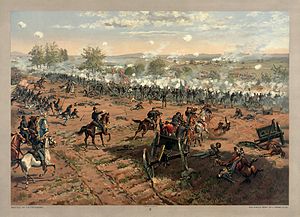 it was not enough for Nicholas. While teaching school, he began to study medicine, and received a diploma from a medical college at Nashville, Tennessee. When I think about the challenges of being a doctor in post Civil War America, with only one arm, and during a time when prosthetics were primitive at best, I am amazed. Still, Nicholas was not satisfied. He entered politics, and represented his county in the Legislature, and afterward was a practitioner of medicine in Reynolds, Mississippi, and he was an elder in the Presbyterian Church. No matter what challenges hit Nicholas, he met them head on, and succeeded in every endeavor he took on. He was not a man content to settle on the ordinary. He was truly an amazing man.
it was not enough for Nicholas. While teaching school, he began to study medicine, and received a diploma from a medical college at Nashville, Tennessee. When I think about the challenges of being a doctor in post Civil War America, with only one arm, and during a time when prosthetics were primitive at best, I am amazed. Still, Nicholas was not satisfied. He entered politics, and represented his county in the Legislature, and afterward was a practitioner of medicine in Reynolds, Mississippi, and he was an elder in the Presbyterian Church. No matter what challenges hit Nicholas, he met them head on, and succeeded in every endeavor he took on. He was not a man content to settle on the ordinary. He was truly an amazing man.
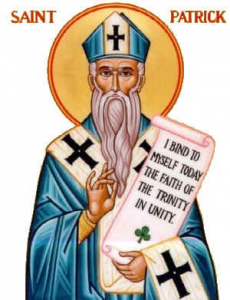 Many holidays get their start on the birth or death of someone famous or very special, and Saint Patrick’s Day is no exception. It was the day that Saint Patrick died in Saul, Ireland. I’m sure that wasn’t surprising to anyone. So, the question then becomes, who was Saint Patrick, and why is he being honored?
Many holidays get their start on the birth or death of someone famous or very special, and Saint Patrick’s Day is no exception. It was the day that Saint Patrick died in Saul, Ireland. I’m sure that wasn’t surprising to anyone. So, the question then becomes, who was Saint Patrick, and why is he being honored?
Saint Patrick was a Christian missionary, bishop, and apostle of Ireland, but that in and of itself was not what made him famous. He lived in a time in history when little would be known of a person’s life if no one took the time to write things down. The Internet, Facebook, and Twitter were far off in the very distant future, so people wrote letters and kept journals. Saint Patrick wrote a book that he titled, “Confessio”, during his last year of life, and it is from these writings that we know what we know of him.
Saint Patrick was born in Great Britain probably in Scotland, to a wealthy Christian family of Roman citizenship. At the age of about 16 years, he was captured be Irish marauders and made to be a slave. For the next six years he worked as a herder in Ireland. Due to the long lonely days, far from family and other human companionship, he drew closer and closer to God for comfort. After hearing a voice in a 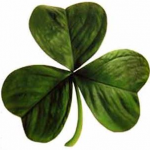 dream one night, he escaped and found passage on a ship that took him back to Great Britain and his family. Once he was back with his family, he had another dream. In the dream someone named Victoricus gave him a letter entitled “The Voice of the Irish.” He felt like the Irishmen were pleading with him to go back to Ireland.
dream one night, he escaped and found passage on a ship that took him back to Great Britain and his family. Once he was back with his family, he had another dream. In the dream someone named Victoricus gave him a letter entitled “The Voice of the Irish.” He felt like the Irishmen were pleading with him to go back to Ireland.
In 433, he returned to Ireland, after studying to become an ordained Christian minister and started preaching the Gospel. Thousands of Irishmen were converted to Christianity and many churches were built all around Ireland. After 40 years of devoting his life to God and His work, Saint Patrick died on March 17, 461, in the town of Saul, Ireland, which is where he built his first church.
Since his passing, many legends have grown up about him. He was made the patron saint of Ireland, and 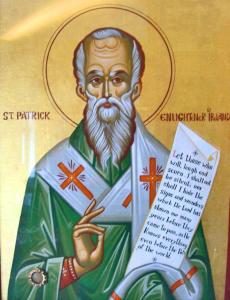 people say that he baptised hundreds of people in a single day. He is also said to have used a three-leaf clover, which became the famous shamrock to describe the Holy Trinity. He is portrayed as trampling snakes because it is said that he had driven them out of Ireland. The Irish observe the day of his passing as a national holiday, attending church in the mornig and celebrating with food and drink in the afternoon. Later the rest of the world jumped on board, and the first Saint Patrick’s Day parade was celebrated in the United States, and involved Irish soldiers serving in the English military marching through the streets of New York City in 1762. The parades became a show of unity and strength for the Irish-American immigrants and the party went global in 1995 when the Irish government started a campaign to matket Saint Patrick’s Day as a way of driving tourists to Ireland. Today, March 17th is still celebrated by millions of people, many of whom probably have no idea what this man stood for. It’s something to think about for sure. Happy Saint Patrick’s Day!!
people say that he baptised hundreds of people in a single day. He is also said to have used a three-leaf clover, which became the famous shamrock to describe the Holy Trinity. He is portrayed as trampling snakes because it is said that he had driven them out of Ireland. The Irish observe the day of his passing as a national holiday, attending church in the mornig and celebrating with food and drink in the afternoon. Later the rest of the world jumped on board, and the first Saint Patrick’s Day parade was celebrated in the United States, and involved Irish soldiers serving in the English military marching through the streets of New York City in 1762. The parades became a show of unity and strength for the Irish-American immigrants and the party went global in 1995 when the Irish government started a campaign to matket Saint Patrick’s Day as a way of driving tourists to Ireland. Today, March 17th is still celebrated by millions of people, many of whom probably have no idea what this man stood for. It’s something to think about for sure. Happy Saint Patrick’s Day!!
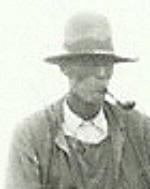 My great grandfather, Cornelius Byer was a friend of the Indians at a time in history, when that was rather uncommon. During his lifetime, the White Man was well known for backing out on treaties as the need or desire for more land warranted, resulting in the pushing back of the Indians further and further off of the land they had been promised. This of course eventually resulted in the placement of the Indians onto reservations, many of which still exist to this day. It also cause much contention between the Indians and the White Man, and of course, the Indian Wars. At that time and even beyond, many Indians did not trust the White Man, even after peace came about, however my great grandfather was a man they not only trusted, but indeed, loved and respected. Over the years, the family would see many times when the Indians would show up at the house, with their whole families in tow. The women and children always waited outside while the men went in to visit with Grandpa about whatever it was they had come for. For the children, I suppose all this seemed normal, but when we look at it in light of history, it seems strange to think of the Indians having such trust and respect for any White Man, and therefore strange to think that they came to the house, and that they were welcomed into it. Nevertheless, this is what happened, and Great Grandpa Byer went to their villages as well.
My great grandfather, Cornelius Byer was a friend of the Indians at a time in history, when that was rather uncommon. During his lifetime, the White Man was well known for backing out on treaties as the need or desire for more land warranted, resulting in the pushing back of the Indians further and further off of the land they had been promised. This of course eventually resulted in the placement of the Indians onto reservations, many of which still exist to this day. It also cause much contention between the Indians and the White Man, and of course, the Indian Wars. At that time and even beyond, many Indians did not trust the White Man, even after peace came about, however my great grandfather was a man they not only trusted, but indeed, loved and respected. Over the years, the family would see many times when the Indians would show up at the house, with their whole families in tow. The women and children always waited outside while the men went in to visit with Grandpa about whatever it was they had come for. For the children, I suppose all this seemed normal, but when we look at it in light of history, it seems strange to think of the Indians having such trust and respect for any White Man, and therefore strange to think that they came to the house, and that they were welcomed into it. Nevertheless, this is what happened, and Great Grandpa Byer went to their villages as well.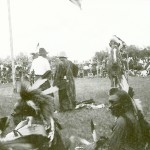
On one such visit to the Indian village of Chief Red Cloud, my grandfather, George Byer was allowed to go along. He recalled that when they entered the tent, Chief Red Cloud was sitting by a fire wrapped in his robe or blanket. Apparently it was customary in this case for him to have little or nothing on underneath that, so I almost have to wonder if it was a sweat lodge or something. Either way, that is what my grandfather recalled as a young boy of about ten years. His dad had gone to visit Red Cloud about something, and in during the visit, the peace pipe was passed around. When it was handed to my grandfather, he was allowed to take it and that resulted in his smoking the peace pipe for the first time as a very young boy, who was apparently considered man enough to do so by the Indians. I doubt if many of us can say, in this day and age, that they know someone who smoked a peace pipe before, but that is the truth.
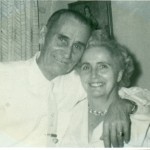
My great grandpa was so greatly respected that not only was he asked to smoke the peace pipe with them, but when he was dying, a rather amazing thing happened. Because he had been their friend, the Indians came to pay their respects. As they had before, they brought their families, but this time the families did not stay outside. The braves came in to shake Great Grandpa’s hand, as did their wives, and their children. Every single one of them shook his hand…from the oldest to the youngest. It was such a moving show of respect for him, and one that was almost never afforded to a White Man. But then, Great Grandpa Cornelius Byer was their friend, and that made him more than just any other White Man. He was like a brother to them.
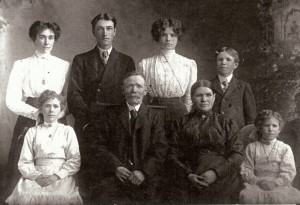 Each of us looks back on our life at one point or another, to reflect on all that has transpired, and the roads traveled to get to the point at which we have arrived. One of the things that often becomes the subject of such reflection, is just how we knew that our parents loved us. Sometimes people mistakenly talk about all the things their parents have given them. Of course, these people are usually teenagers, who have gone beyond the innocent understanding that love isn’t about things, but have not yet reached the point of adulthood, when they will understand that it is often the life lessons taught rather than the gifts received that they value the most.
Each of us looks back on our life at one point or another, to reflect on all that has transpired, and the roads traveled to get to the point at which we have arrived. One of the things that often becomes the subject of such reflection, is just how we knew that our parents loved us. Sometimes people mistakenly talk about all the things their parents have given them. Of course, these people are usually teenagers, who have gone beyond the innocent understanding that love isn’t about things, but have not yet reached the point of adulthood, when they will understand that it is often the life lessons taught rather than the gifts received that they value the most.
In reading my Great Aunt Bertha Hallgren’s journal, I noted that one of the ways she felt the love her father had for her was that he made sure that they were in school, except when they were ill. Even though they lived further away than any of the other children at the school, their attendance was the best by far. The children were wrapped tightly in warm blankets for the journey on those cold North Dakota winter days, but they were in school nevertheless. Great Grandpa Carl Schumacher knew the importance of an education, and was determined that his children would have one. Whenever I hear of a student who wishes their parents wouldn’t make them go to school, I am reminded first that they are very young and naïve, and second that they will 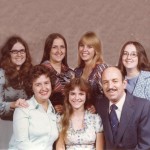 someday feel differently about that whole situation.
someday feel differently about that whole situation.
I know of many parents who have given their children a car and other such expensive gifts, and people seem to feel like they must love them very much. I suppose that could be true, but at the same time, the child has been cheated out of an important life lesson…earning the things you want. When my girls were preparing to drive, I told them that they would need a car, a driver’s license, gasoline, insurance, and a job to pay for all that. I suppose that there were people who saw that as mean on my part, but it is one of the life lessons that my girls look back on fondly. They never felt cheated, they felt empowered. That was the gift they were given, and to this day, they are both strong, capable women, who have raised their children in much the same way. I’m not saying anything against parents who did give their kids a car and such, but rather that this was the standard we chose to give our children. I’m also sure that parents who gave their children a car have taught them other life lessons that their children look back on when they reflect on the love their parents have for them. That is the privilege each parent has…to raise their children in the way that they see fit.
I look back on my own parents, and the standards they set for us, with a sense of pride, because they were great parents. We were never given a car…probably, that is why I did things as I did, but we were give much love, and guidance. We had chores to do, and we helped with cooking. We can all cook and keep house to this day too. We didn’t get to eat out all the time, so when we did, it was a special treat, but I never felt like that I was cheated in any way. My parents showed their love in so many other ways. They raised us to be respectful, and as a result, respected. They showed us love, no matter what, and as a result, we know how to show love…no matter what. They showed us that just as God forgives us for our sins, we need to be forgiving of others and especially not to let the sun go down on your anger. They showed us unconditional love. We knew that nothing we did was going to lose us the love of our parents. Oddly, that made us try harder to do good…or maybe that was their plan all along. Looking back on those times makes me realize that the best way to show you love your child is to live it. Teach them values mixed with compassion, and they will try their hardest to live up to the standards you set for them. That is a real show of love.
was cheated in any way. My parents showed their love in so many other ways. They raised us to be respectful, and as a result, respected. They showed us love, no matter what, and as a result, we know how to show love…no matter what. They showed us that just as God forgives us for our sins, we need to be forgiving of others and especially not to let the sun go down on your anger. They showed us unconditional love. We knew that nothing we did was going to lose us the love of our parents. Oddly, that made us try harder to do good…or maybe that was their plan all along. Looking back on those times makes me realize that the best way to show you love your child is to live it. Teach them values mixed with compassion, and they will try their hardest to live up to the standards you set for them. That is a real show of love.

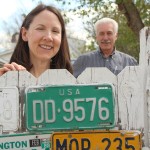 I don’t know for sure how it all started, but over the years, my father-in-law, Walt Schulenberg collected a number of old license plates that were both unique and average. My guess is that he found one that he really liked, and he saved it, putting it up on the wall of the garage. Before long, the number of plates grew, because there was always another unique license plate to add to the collection. After a while the license plate collection grew to include plates from the different states he had been in, and his son, Ron Schulenberg even brought him some from the countries he was in during Desert Storm…which were quite different from all the others.
I don’t know for sure how it all started, but over the years, my father-in-law, Walt Schulenberg collected a number of old license plates that were both unique and average. My guess is that he found one that he really liked, and he saved it, putting it up on the wall of the garage. Before long, the number of plates grew, because there was always another unique license plate to add to the collection. After a while the license plate collection grew to include plates from the different states he had been in, and his son, Ron Schulenberg even brought him some from the countries he was in during Desert Storm…which were quite different from all the others.
These license plates started out gracing the walls of the garage, which is a fitting place for such a collection, but as time went on, there were enough of then to warrant adding the barn shop my father-in-law had, and finally the back fence to his display areas. In reality, while I found these interesting to look at from time to time, my father-in-law’s license plate was not something that occupied any kind of a special place in my mind. I suppose that if I was a guy, I might have felt differently about it. It is a guy type of collection, after all.
After someone passes away, and you find yourself sorting through all their things, you begin to really get a feel for what was important to them. Not just the major things they had placed a high degree of importance on, but the lesser things too. The things they just liked, because they thought those things were cool. That was how it was for me, when we started going through my father-in-law’s things. No, I can’t say that I wanted those old license plates, but they were interesting. They were a reminder of my father-in-law, and the things he liked.
After the funeral, we took some pictures, as often happens after funerals, simply because many people who come, don’t live here and you want their pictures, because you don’t see them often enough. Many of the people in the family wanted their picture taken by the back fence, showing that collection of license plates. The other day, as I was looking through some of the old pictures, I came across those that were taken that day. It 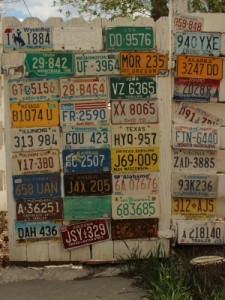
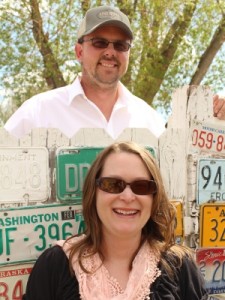 made me think with interest about the array of license plates my father-in-law had collected, and in reality about the kind of man he was.
made me think with interest about the array of license plates my father-in-law had collected, and in reality about the kind of man he was.
The things that were cherished to him were really the life moments. Things like his knife and watch, his tools, his woodworking supplies and chair making supplies, and yes, the license place collection, were things that had a special meaning to him. They were like the stories of his life. They were the accomplishments he had made, the places he had been, and the reminders of just how precious life was. While the license plates were not something I was interested in receiving, I am very glad that I have pictures of them to remember his passion for life.
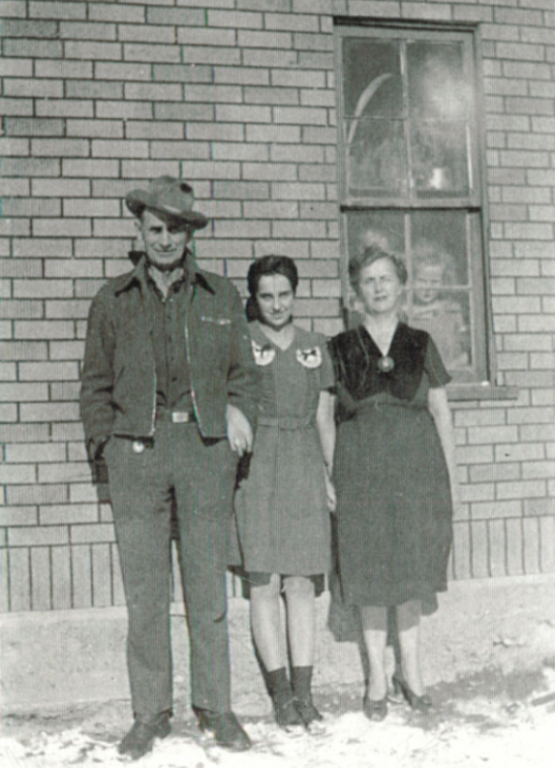 When most people think of the barracks, they think of a military facility, but not so my mother’s family. For all of their childhood, the barracks meant the bedroom. No, it isn’t because that is what they called the bedroom, because, they didn’t call the bedroom that. While visiting with my aunts, Sandy Pattan and Bonnie McDaniels, and cousins Susie Young, Shannon Limmer, and Jamie Patsie, after my mother passed away a week ago, we got on the subject of precious memories…which naturally took us to my grandpa and grandma, George and Hattie Byer’s house in North Casper, where they lived for many years right next door to his mother, my great grandma, Edna Byer. The two houses were very similar, but my grandparents house had an extra, very long bedroom attached to the back of the house. Grandma and Grandpa’s room was in from of that back bedroom, and there was another room where the two boys slept, but the girls all shared that huge back bedroom.
When most people think of the barracks, they think of a military facility, but not so my mother’s family. For all of their childhood, the barracks meant the bedroom. No, it isn’t because that is what they called the bedroom, because, they didn’t call the bedroom that. While visiting with my aunts, Sandy Pattan and Bonnie McDaniels, and cousins Susie Young, Shannon Limmer, and Jamie Patsie, after my mother passed away a week ago, we got on the subject of precious memories…which naturally took us to my grandpa and grandma, George and Hattie Byer’s house in North Casper, where they lived for many years right next door to his mother, my great grandma, Edna Byer. The two houses were very similar, but my grandparents house had an extra, very long bedroom attached to the back of the house. Grandma and Grandpa’s room was in from of that back bedroom, and there was another room where the two boys slept, but the girls all shared that huge back bedroom.
We always loved to go play back there, because it was a long room with lots of beds, and it just seemed very interesting to all the grandkids. I suppose that to the aunts and uncles, it was just normal, be we had really never seen anything like it. We began to talk about what spending the night in that back bedroom was like. There was no heat in that back room, so at night grandpa would heat rocks in the cook stove, and wrap them in a towel. Once the girls were tucked into bed, under a mountain of blankets, grandpa would come in and stick those towel wrapped rocks under the blankets at their feet. What a wonderful thing those rocks were. Aunt Bonnie tells me that they would immediately put their feet on those rocks, and before long, they would be all warm and cozy for the night. In the absence of heat, the blankets and the rocks did the job of keeping them warm quite well.
For us grandkids, the best way to play in that room in the winter cold, was to keep moving. I don’t think my aunts spent much time in there other than sleeping, because it was just too cold in winter. The main living room and kitchen were heated by the cook stove, and I’m here to tell you that those rooms were very warm…a fact that was just fine with me, since I have a tendency to get cold. Nevertheless, after some time in the main part of the house, the cooler bedroom could come as a nice change, until you got cold, then you went back out to the main rooms to warm up.
I had always wondered about the house with the long bedroom, and how it came to be…but no longer. As we were talking about those old days, my Aunt Sandy cleared that question right up. It turns out that both houses, Great Grandma’s and my grandparents, were originally old barracks from the air force base that used to be 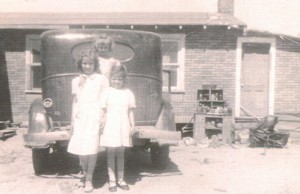 located in Casper. I don’t know for sure when they became the two houses, but that is what happened. My grandparents’ house had the added barracks to it, making up the big back bedroom where so many childhood memories for my mom, aunts, uncles, and many of the grandchildren, were built. In those days, times were tough, and people had to make do with what they had. In my opinion, the barracks and the houses attached to them, were more than just a way to make do. They are the houses I remember fondly from my own childhood years. We used to love going to visit Grandma and Grandpa. The house was always cozy, and my grandparents always pleased to see us. I get a warm cozy feeling just thinking about those visits.
located in Casper. I don’t know for sure when they became the two houses, but that is what happened. My grandparents’ house had the added barracks to it, making up the big back bedroom where so many childhood memories for my mom, aunts, uncles, and many of the grandchildren, were built. In those days, times were tough, and people had to make do with what they had. In my opinion, the barracks and the houses attached to them, were more than just a way to make do. They are the houses I remember fondly from my own childhood years. We used to love going to visit Grandma and Grandpa. The house was always cozy, and my grandparents always pleased to see us. I get a warm cozy feeling just thinking about those visits.

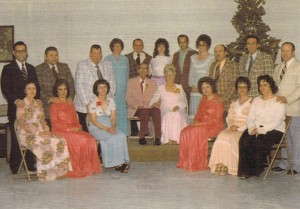 From the moment he first met her, my dad always called my mom, Doll. It was a term of endearment reserved for Dad alone to use. To us, of course, she was mom, or mommy when we were little, but to everyone who really knew her, she was the keeper of the sunshine. Mom was a person who was always happy. Even when times were tough, she managed to lift our spirits by always telling us to, “keep on the sunny side” whenever we left her house. It was the way we went to school, and later to work. Those were the words we heard after we had lunch or dinner at her house. She wanted our world to always have a bit of sunshine in it…even on a cloudy day.
From the moment he first met her, my dad always called my mom, Doll. It was a term of endearment reserved for Dad alone to use. To us, of course, she was mom, or mommy when we were little, but to everyone who really knew her, she was the keeper of the sunshine. Mom was a person who was always happy. Even when times were tough, she managed to lift our spirits by always telling us to, “keep on the sunny side” whenever we left her house. It was the way we went to school, and later to work. Those were the words we heard after we had lunch or dinner at her house. She wanted our world to always have a bit of sunshine in it…even on a cloudy day.
Mom was a dedicated servant of God…spreading His word to all who would listen…and some who didn’t want to. She wanted everyone, but especially those she loved, her parents, siblings, husband, children, and grandchildren, as well as all her extended family to be in Heaven when they left this world. She loved the Lord so much and looked forward to the day when she would be able to look upon His face, and thank Him for saving her. She loved going to church and singing praises to God, and hearing His word. She bought many teaching tapes and books, because she wanted to know all she could about this wonderful Saviour who loved her…no matter what!!
Mom loved a celebration. Being born on New Year’s Day, her birthday was always a celebration…Dad always made certain of that. He love a celebration too. Mom loved the Fourth of July fireworks, and the parade. Anyone who knows her…or ever sat next to her…will remember her whooping when a float or one of the fireworks particularly pleased her…and many of them did…many of them!! Looking back now on her whooping, it somehow doesn’t seem so embarrassing as it did in my younger days. I suppose all kids think the things their parents do are embarrassing sometimes. Nevertheless, that didn’t stop Mom. She was filled with joy, and sometimes…no, most of the time…it just bubbled out. She couldn’t have stopped it even if she had wanted to. And that’s ok, because even if you were embarrassed about it, it always made you smile in spite of your dignified self.
Late Sunday night, February 22, 2015, my dear mother left this world to go and meet the Saviour she had so long dreamed of meeting. I know He greeted her with the words, “Well done thou good and faithful servant”, because she was definitely that. I also know that she was met with some other cherished words. I expect, like my niece Jenny said, that my dad was standing there at the gates, and he immediately said, “Hello Doll.” It has been just over seven long years since he left us, and Mom has missed him so much. The next sweet words she likely heard were, “Hi Grandma!!” spoken by her two little great granddaughters, Alyssa and Laila, “We’ve been waiting to get to know you!!” And of course, there were greeting from her parents, in-laws, siblings, and other family members who have gone ahead of her. Yes, Heaven gained a new little bit of sunshine last Sunday evening, and the Earth just doesn’t seem quite as bright as it was before, because our Keeper of the Sunshine has gone to her Heavenly home.
Mom went home on her terms. She went healthy. She had a great week, having lunch with her kids, and going to dinner on Thursday night with my sister, Cheryl Masterson and me, at her favorite place…Red Lobster. She went to church on Sunday morning and very much enjoyed being surrounded by her beloved family and church 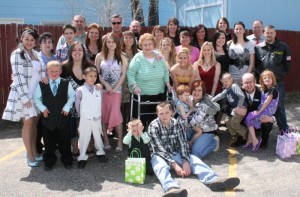
 family, all of whom she considered to be a great blessing. She set up a visit with her sisters, brother, and other family members to go spend the afternoon with her sister, Evelyn, who was in the hospital. She and Cheryl had a nice quiet evening, and then Mom was going to bed, but she decided to go to Heaven instead. Mom, we miss you so much already. Our lives will never be the same again…until we are together forever in Heaven. We love you so very much. We will see you again very soon.
family, all of whom she considered to be a great blessing. She set up a visit with her sisters, brother, and other family members to go spend the afternoon with her sister, Evelyn, who was in the hospital. She and Cheryl had a nice quiet evening, and then Mom was going to bed, but she decided to go to Heaven instead. Mom, we miss you so much already. Our lives will never be the same again…until we are together forever in Heaven. We love you so very much. We will see you again very soon.

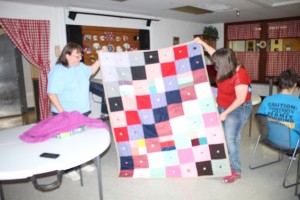 Over the years, my sister-in-law, Debbie Cook has tried her hand at a variety of different crafts. Debbie had always done a lot of sewing, and had made her daughters clothing. Sewing was never really my thing, although I could sew if I wanted to. I just never really wanted to. Debbie enjoyed it though, and the clothes she made were very nice. It was something she shared with her mother…that ability to sew and to enjoy doing it.
Over the years, my sister-in-law, Debbie Cook has tried her hand at a variety of different crafts. Debbie had always done a lot of sewing, and had made her daughters clothing. Sewing was never really my thing, although I could sew if I wanted to. I just never really wanted to. Debbie enjoyed it though, and the clothes she made were very nice. It was something she shared with her mother…that ability to sew and to enjoy doing it.
Debbie also took up cross stitch and for years made pictures that she sold at the many craft fairs that she and several other family members had booths at over the years. For the most part, the cross stitch projects were done by Debbie and Brenda, but there were a few others in the family, myself included. Nevertheless, Debbie made a number of sweet pictures to give as gifts to many people in the family, and we who have received them, have cherished them ever since we got them.
More recently, Debbie got into quilting, and like most people who find that they like quilting, she found that it was maybe her calling. I’m not sure when she got started exactly, but I remember that while her dad, Walter 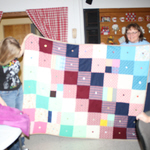
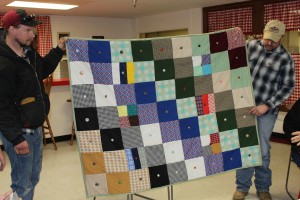 Schulenberg was alive, she made a quilt for him. I don’t recall exactly if she made the original one for him, but I think she did, and then, because of how cold he always got, she actually took it apart and turned it into two lap quilts. Now that ability really impressed me. It is one thing to make a quilt, but then to alter the quilt in such a way…well, that takes a degree of talent, especially when the quilt had the frayed edges that are so popular these days.
Schulenberg was alive, she made a quilt for him. I don’t recall exactly if she made the original one for him, but I think she did, and then, because of how cold he always got, she actually took it apart and turned it into two lap quilts. Now that ability really impressed me. It is one thing to make a quilt, but then to alter the quilt in such a way…well, that takes a degree of talent, especially when the quilt had the frayed edges that are so popular these days.
After Dad’s passing, we, the kids and children-in-law, decided that since Mom was in a nursing home now, we wanted to turn their old clothes into quilts to be cherished memories for all of us. We weren’t sure how big they would be able to be, and we had asked a family friend, Linda Hall to make the ones for the five living children. Then Debbie approached me and said that she had really wanted to help with those, so it was decided that she would use part of the material to make memory quilts for the grandchildren. Those were exciting days of anticipation for the children and the grandchildren. It was such a great idea that my sister-in-law, Brenda Schulenberg had come up with.
All of the quilts were finished between Thanksgiving and mid-January. They were such a blessing to receive. 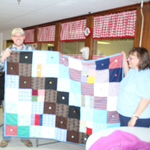
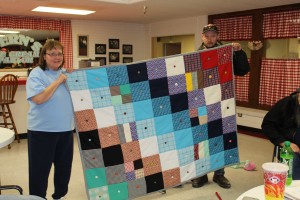 Both of the girls did a wonderful job on them. Debbie has now decided that she wants to make a set for the great grandchildren, and we are all looking forward to seeing those too. What a blessing that will be for the great grandchildren, some of whom have never even met their great grandfather, or their great great grandparents, whose clothes will also be used in these, but will now have a memory of them anyway. We can’t wait. Today is Debbie’s birthday. Happy birthday Debbie!! Have a great day!! We love you!!
Both of the girls did a wonderful job on them. Debbie has now decided that she wants to make a set for the great grandchildren, and we are all looking forward to seeing those too. What a blessing that will be for the great grandchildren, some of whom have never even met their great grandfather, or their great great grandparents, whose clothes will also be used in these, but will now have a memory of them anyway. We can’t wait. Today is Debbie’s birthday. Happy birthday Debbie!! Have a great day!! We love you!!
 For many people researching the family history means looking for things like famous ancestors, family occupations, historical locations, and eventually the family crest, also known as the Coat of Arms. The problem with the family crest is that there are so many, and the process to make a legal claim to one is difficult, because the right to bear arms in the legal sense of a coat of arms, must be researched and proven through attested Genealogical records. Of course, this doesn’t mean that people can’t pick out a crest that bears their name and use it, even without the legal documentation. They can be displayed as decorative reproductions, derived only from the association with your name. That use, while legal in the sense that you are not committing a crime, is not the legal right to bear arms that is normally associated with the crest.
For many people researching the family history means looking for things like famous ancestors, family occupations, historical locations, and eventually the family crest, also known as the Coat of Arms. The problem with the family crest is that there are so many, and the process to make a legal claim to one is difficult, because the right to bear arms in the legal sense of a coat of arms, must be researched and proven through attested Genealogical records. Of course, this doesn’t mean that people can’t pick out a crest that bears their name and use it, even without the legal documentation. They can be displayed as decorative reproductions, derived only from the association with your name. That use, while legal in the sense that you are not committing a crime, is not the legal right to bear arms that is normally associated with the crest.
Sometimes, for those who are very fortunate, the family coat of arms might be found in a grandparent’s attic, but most of us will not discover our true coat of arms in this manner. Because of the difficulty in locating the necessary information to claim a legal right to a family coat of arms, most people just don’t bother with this part of a full family history. According to LG Pine, author of Heraldry And Genealogy, “At the onset, there is a curious fact in the relationship between the two subjects. While students of Heraldry do take to Genealogy, and acquire a considerable knowledge of it, those who begin as genealogists seldom if ever take any interest in Heraldry. This is most unfortunate, because the two subjects are necessarily related.” I suppose this is true, but once you have stumbled upon a family coat of arms in your research, like I did a few years ago, you simply do become intrigued.
Nevertheless, I had no idea about the legal right to bear arms until I was doing some research into the coat of arms of the Leary side of Bob’s family the other day. I had found several family coats of arms for the Spencer, Byer, Pattan, Fuller, and Schulenberg sides of the family, and planned to look for some of the others in the near future. While I will still do that, I have to wonder about the accuracy of the ones I have, and just how 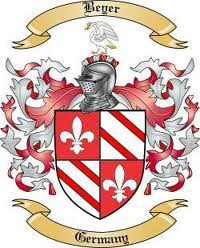 difficult it will be to verify their validity. I can see that I will need to do some research on just how to move forward on this matter in the correct way.
difficult it will be to verify their validity. I can see that I will need to do some research on just how to move forward on this matter in the correct way.
The biggest obstacle I see in researching Heraldry or Genealogy is that the spelling of names changes. Whether it is because the person moved to a new nation and was made to change their name or spelling, or like many people do with their first names these days, the person experimented with the spelling of their last name. William Shakespeare was known to spell his last name Shakespeare, Shakespere, Shakespear, Shakspere, and Shaxpere. So to the researcher, I suppose it would be a matter of searching for documentation under multiple different spellings. You can see that the further you get into a search, the more difficult it is to determine the accuracy. So now apply that to the search concerning the legal right to bear arms, and I think you might have the answer as to why so many people avoid this area of research altogether.
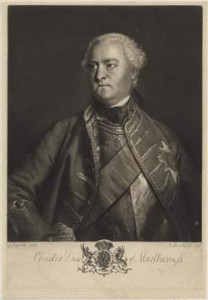 The dukedom of Marlborough is one of the titles in the Peerage of England. The Peerage of England comprises all peerages created in the Kingdom of England before the Act of Union in 1707. In that year, the Peerages of England and Scotland were replaced by one Peerage of Great Britain. The peerage is a legal system of largely hereditary titles in the United Kingdom, which is constituted by the ranks of British nobility and is part of the British honors system. The dukedom of Marlborough was created by Queen Anne in 1702, for John Churchill, who was the 1st Duke of Marlborough.
The dukedom of Marlborough is one of the titles in the Peerage of England. The Peerage of England comprises all peerages created in the Kingdom of England before the Act of Union in 1707. In that year, the Peerages of England and Scotland were replaced by one Peerage of Great Britain. The peerage is a legal system of largely hereditary titles in the United Kingdom, which is constituted by the ranks of British nobility and is part of the British honors system. The dukedom of Marlborough was created by Queen Anne in 1702, for John Churchill, who was the 1st Duke of Marlborough.
I can’t say that I completely understand all there is to about the peerage of Great Britain, but in the peerage, a Duke is a higher rank than a Marquess, Earl, Viscount and Baron. Thus Prince William is the Duke of Cambridge, because as the prince, it would not be right for him to have a lower rank than other members of the peerage. Originally dukes were the rulers of the provinces of the Roman Empire. Now however, the title of duke has become in almost all cases a nominal rank, without possession of an actual principality. The province that a duke was titled over, is known as a duchy. As I said, in modern times dukes aren’t really over a duchy, with the exception of Lancaster and Cornwall, both of which do include land and ownership. Lancaster belongs to Queen Elizabeth II and Cornwall to Prince Charles. The title of duke cannot normally be handed down to female heirs, but the Dukedom of Marlborough is the exception to that rule. It is one of the few titles that allows females to inherit the title, and the only current dukedom to do so.
In the Spencer family, there have been a number of titles, but it wasn’t until Charles Spencer, 3rd Earl of Sunderland, widowed following the death of his first wife, Arabella, daughter of Henry Cavendish, 2nd Duke of  Newcastle, married Anne Churchill, that the Dukedom of Marlborough first came to the Spencers. With this dukedom, Charles Spencer was first introduced to politics, making this alliance between Sunderland and Marlborough a very important one for Charles and his descendants. From his marriage to Anne Churchill who would become the 2nd Duke of Marlborough, the Spencer family would retain the dukedom for all time. At the current time, the dukedom is at 12, with Charles James Spencer-Churchill, 12th Duke of Marlborough, born in 1955, as the current duke.
Newcastle, married Anne Churchill, that the Dukedom of Marlborough first came to the Spencers. With this dukedom, Charles Spencer was first introduced to politics, making this alliance between Sunderland and Marlborough a very important one for Charles and his descendants. From his marriage to Anne Churchill who would become the 2nd Duke of Marlborough, the Spencer family would retain the dukedom for all time. At the current time, the dukedom is at 12, with Charles James Spencer-Churchill, 12th Duke of Marlborough, born in 1955, as the current duke.
To date, I cannot say how many dukes and duchesses were or are Spencer descendants, for names change with marriages over the years. Nevertheless, the Spencers have played a great part in the peerage of Great Britain, and with Prince William and his descendants, beginning with Prince George, the Spencers will continue to have great influence in that nation for the rest of time.

